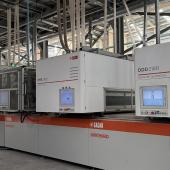Soaring gas prices hold back the Spanish tile industry
Spanish tile production fell by 15% last year, with both exports and domestic sales down 13% respect to 2021. Total revenues grew by 16% as a result of higher selling prices.

The 2022 end-of-year figures unveiled at Cevisama by Ascer chairman Vicente Nomdedeu leave no doubt as to the true extent of a crisis that in the space of just a few months has extinguished the Spanish ceramic tile industry’s sense of euphoria following the excellent post-pandemic recovery in 2021.
In 2022, Spanish ceramic tile production contracted by 15% from 587 to 500 million sqm while total sales volumes fell by 13% with similar declines in the domestic market and exports, down in volume terms from 496 million sqm in 2021 to around 432 million sqm.
The only positive figure was the increase in the sector’s sales revenues (up 16.2% to €5,538 million, approximately €770 million more than in 2021), but not even this offered much comfort to the industry’s business leaders as it was exclusively the result of the higher selling prices introduced by the Spanish ceramic tile producers as a way of offsetting the higher energy prices and consequently overall production costs. Unfortunately, this policy has been only partially successful and has the added disadvantage of undermining the industry’s competitiveness in international markets at a time of slowing demand.
Mr Nomdedeu makes no secret of his concern when, numbers in hand, he describes the magnitude of the problem.
“Gas prices have increased tenfold and now make up the biggest of all our industrial costs. Our industry’s total energy bill (gas + electricity) rose from €939 million in 2021 to €2,235 million in 2022, equivalent to 40% of turnover. This represents an increase of approximately €1,300 million, which has only partly been offset by the price increases. Another reason why the impact was so severe is that, unlike other European competitors such as Italy, we have received no support from the Spanish government despite calling for urgent action for months to help prop up the sector. The only response we have received to date [Editor’s note: 28 February 2023] is an offer of temporary loans, which will not solve the problem, and the promise of a future €450 million credit facility, which is also difficult to accept because it is subject to conditions that are simply too restrictive for the majority of companies. Until now, companies have had to shoulder the burden of increased costs themselves, but the consequences are plain to see. We have seen 10 consecutive months of falling production levels (including month-on-month contractions of 25% in December 2022 and 30% in January 2023). More than forty kilns are currently out of operation, and in the six months from July 2022 to January 2023 we lost 1,017 jobs, in addition to the employees who have been temporarily laid off on a rotating basis through the Spanish redundancy fund mechanism ERTE”.
Although exports figures clearly show that Spanish tiles are now less competitive, Nomdedeu remains relatively confident:
“It will not be easy to make up lost ground, but if government aid arrives and the price of gas continues to fall, we are confident that we will succeed. We may even regain 5% of production to reach 520 million sqm as early as this year”.
Read the full interview published in CWR 150
Did you find this article useful?
Join the CWW community to receive the most important news from the global ceramic industry every two weeks




















